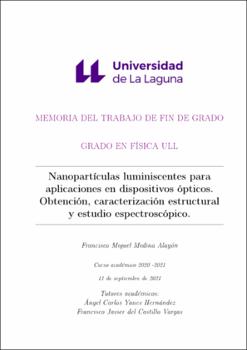Nanopartículas luminiscentes para aplicaciones en dispositivos ópticos. Obtención, caracterización estructural y estudio espectroscópico.
Date
2021Abstract
Despite the apparent relationship of nanoparticles with modern science, it is known
that the first records of their use date back to the Middle Ages, where they were made
using primitive methods for the purpose of embellishing artistic representations. However,
it is not until today that the potential applications of nanostructured materials are being
used, covering scientific fields ranging from medicine, with the development of luminescent biocapsules for the treatment of some serious diseases, to the energy and ligthing
sectors, with the substantial improvement of the efficiency in photovoltaic panels and the
quality of illumination. In particular, if these materials are doped with rare earth ions,
important luminescent properties and photonic effects emerge from them, as is the case
of the up-conversion phenomenon, which can be especially interesting in photocatalytical applications, as for example, the hydrogen production through water-splitting or the
treatment of wastewater.
In the present work, different nanostructured materials based on N aY bF4 and doped
with ions of Eu3+ (5 % and 2 %) or Tm3+ (1 %) through different synthesis methods have
been elaborated, so that its advantages over traditional methods have been reaffirmed: on
the one hand, different nanocristal samples (NCs) were synthesized using the solvothermal
method, which involves organic solvents and surfactants and working with high pressures
and relativelly low temperatures through the use of an autoclave. On the other hand, several nano-glass-ceramics (nGCs) were produced using the sol-gel technique, which allows
to obtain nanostructured materials with optical quality, controlling their composition precisely and working at lower temperatures than conventional melt-quenching techniques.
Additionally, the importance to dope these materials with rare earths lies in the electronic configuration of those ions, since the phenomenon called lanthanide contraction
produces electronic mismatch effects that magnify their magnetic and optical properties
when interacting with visible, ultraviolet and infrared radiation.
The synthesized nanostructured materials were then subjected to structural characterization using X-ray diffraction (XRD), transmission electron microscopy (TEM-HRTEM),
and X-ray dispersive spectroscopy (EDS):
First, XRD measurements confirmed the formation of solvothermal cubic and hexagonal N aY bF4 NCs, with average sizes of 17 nm and 80 nm, respectively (calculated using
the Scherrer equation), showing the possibility to select the nanocrystalline phase in function of the selected heat treatment. Second, the images obtained through TEM-HRTEM
also confirmed the formation of those NCs, with spherical morphology and similar sizes
to the estimated from XRD measurements. Third, the EDS measurements confirmed the
existence of the expected chemical elements within the different samples. Moreover, it was
also confirmed the precipitation of N aY bF4 cubic NCs into the SiO2 matrix for all the
nGCs, with average sizes around 7 nm. Once the structural characterization was completed, a spectroscopic study was carried
out for the different nanostructured materials through different excitation and emission
spectra.
On the one hand, and with the purpose of complementing the structural characterization, an Eu3+ ion environment analysis was carried out, taking advantage of their
properties as a spectroscopic probe to determine the site symmetry of dopant RE3+ ions.
Emission spectra of the solvothermal NCs exciting at 393 nm, corresponding to the
transition 7F0 ⇒5 L6 showed that the ratio of the emissions associated with 5D0 ⇒7 F1
and 5D0 ⇒7 F2, known as the asymmetry ratio, present a value of R = 1.19 for cubic
NCs and R = 1.91 for hexagonal NCs, related with different symmetry sites occupied by
RE3+ ions. On the other hand, a R = 1.31 for the 95SiO2 − 5N aY bF4 : 2 %Eu3+ nGC
was obtained, suggesting an effective distribution of these ions into cubic N aY bF4 NCs.
Moreover, a R = 1.87 when exciting at 464 nm, suggest that some Eu3+ ions remain into
the glassy matrix.
On the other hand, intense UV up-conversion emissions were observed when exciting at 980 nm in cubic and hexagonal Tm3+ doped solvothermal NCs. The overall UC
emissions for the hexagonal NCs result more intense than the corresponding to the cubic
NCs, which can be related with different symmetry sites for the RE3+ ions. Moreover, corresponding intense up-conversion emissions for the Tm3+ doped nGC were also observed.
Furthermore, the proportionality of the intensity of the up-conversion emissions with
the laser pumping power was analyzed from logarithmic representations.Thus, the results
obtained showed saturation effects, since these values were lower than the expected theoretical ones. This phenomenon can be related to the competition between linear decay
and UC processes for the depletion of the intermediate excited levels, and in particular,
in all the studied materials, is related with high amount of Y b3+ ions.
Finally, and taking advantage of the observed intense UV up-conversion emissions,
a methylene blue photocatalysis experiment was carried out in order to evaluate potential industrial applications of these nanostructured materials. On one hand, degradation
curves of the methylene blue obtained from Tm3+ solvothermal NCs showed an important degradation, more intense in hexagonal NCs than in the cubic ones. On the other
hand, a degradation of 31 % was obtained for the Tm3+ doped nGC. These results suggest the possible application of these nanostructural materials in promising applications
in photocatalytic processes, such as the hydrogen generation through water-splitting or
the treatment of wastewater.





